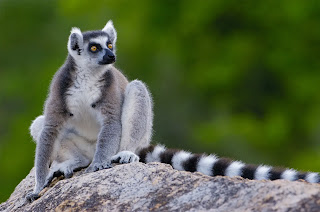
The lemur is a type of small primate that can only be found on the island of Madagascar. There are 5 families of lemurs with more than 50 species and hundreds of subspecies. Lemurs are originally from Africa, but outnumbered by great apes and monkeys. They left Africa 62 to 65 million years ago and came to Madagascar in large rafts of vegetation. With few natural enemies, the lemurs quickly managed to occupy the entire island and develop into numerous species. Unfortunately, 90% of all known species of lemur will probably become extinct in the next 20 to 25 years due to accelerated habitat loss and illegal hunting.
Here are some nteresting Lemur Facts:
The ring-tailed lemurs mating season is from late April to early June.
Lemur can reach 3.6 to 27 inches in length and 1.1 ounce to 20 pounds of weight. Dwarf mouse lemur is the smallest species of lemur, while Indri lemur is the largest.
Lemurs are mammals.
Lemur has thin fur that can be black, grey, brown or reddish colored.
As compared to other species, Ring-tailed Lemurs spend most of their time on the ground.
Lemur has pointed nose, huge eyes and long bushy tail that is much longer than the rest of the body (it can reach 22 to 25 inches in length in the large species). Lemur has human-like hands with opposable thumbs and flat fingernails. Second toe on the hind feet is equipped with claw that is used for grooming.
The lemur is a national animal of Madagascar.
Lemur is very intelligent animal. It can learn to use tool and perform simple arithmetic tasks.
Females ring-tails are pregnant for 135 to 145 days.
Name “lemur” means “spirits of the night” in Latin, and it refers to the nocturnal nature of these animals. Despite the name, some lemurs are also active during the day.
The smallest species of lemurs are known as the Dwarf Mouse Lemur.
Lemur is adapted to the life in the trees, but some species, such as ring-tailed lemur, spend plenty of time on the ground. Lemur can stand on two legs, but it always walks on four legs.
The Dwarf mouse lemur weighs only 30 grams.
Lemur eats fruit, leaves, flowers, tree sap and bark. Plant-based diet is occasionally supplemented with small vertebrates and insects.
Lemurs have flat fingernails like humans.
Lemur plays important role in dispersal of seed in the wild.
Lemurs like to bask in sunlight during the morning.
Lemur can slow down its metabolism and hibernate when food is scarce (the only primate that hibernates).
Lemurs also use their tail as a form of communication.
Most species of lemur live in family groups of around 15 animals. Groups can be composed of animals of both or only one gender. Dominant female is the leader of the group. Some species, such as aye-aye, are solitary.
The lemur uses their second toe for grooming.
Lemurs communicate via scent from the glands on the feet and buttocks, via loud screeching noise and by using their long tails.
They have scent glands on their wrists.
The only natural enemies of lemurs (besides humans) are fossa and the harrier hawk.
Madagascar is home to the fourth largest population of Lemurs.
Lemurs mate only when there is plenty of food. Pregnancy lasts 9 to 24 weeks (depending on the species), and ends with 2 babies in most cases. Different species of lemur can interbreed in the captivity and create new hybrid species.
The largest lemur species is the indri.
Lemurs reach sexual maturity at the age of 2 years.
A group of Lemurs are called troops. Generally, a female lemur is the head of the troop.
Lemur can survive around 18 years in the wild and up to 30 years in the captivity.
Female lemurs have a gestation period of 102 to 170 days.









